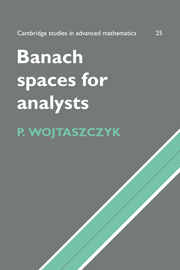I.A - Functional analysis
Published online by Cambridge University Press: 03 May 2010
Summary
1. A linear topological space X is a linear space over the real or complex numbers endowed with a topology τ such that the map (x, y) ↦ x + y is continuous from (X, τ) × (X, τ) into (X, τ) and the map (t, x) ↦ tx is continuous from ℝ × X (or ℂ × X) into X. Such a topology is fully described by a basis of neighbourhoods of 0. A subset V ⊂ X is called convex if whenever x1, x2 ∈ V then the whole interval αx1 + (1 – α)x2 for 0 ≤ α ≤ 1 is in V. A linear topological space is called locally convex if it has a basis of convex neighbourhoods of 0. A functional on X is a continuous linear map from X into scalars. The set of all functionals on X will be denoted X*, and called the dual space. A linear operator (or just operator) T : X → Y (where X and Y are linear topological spaces) is a continuous linear map. A subspace of X will always (unless explicitly stated otherwise) denote a closed linear subspace. Given a set V ⊂ X by spanV we denote the closure of the set of all linear combinations of elements from V (i.e. the subspace of X spanned by V).
2. A linear topological space X is called an F-space if its topology is given by a metric ρ such that ρ(x, y) = ρ(x - y, 0) and X is complete with respect to this metric.
- Type
- Chapter
- Information
- Banach Spaces for Analysts , pp. 3 - 8Publisher: Cambridge University PressPrint publication year: 1991



